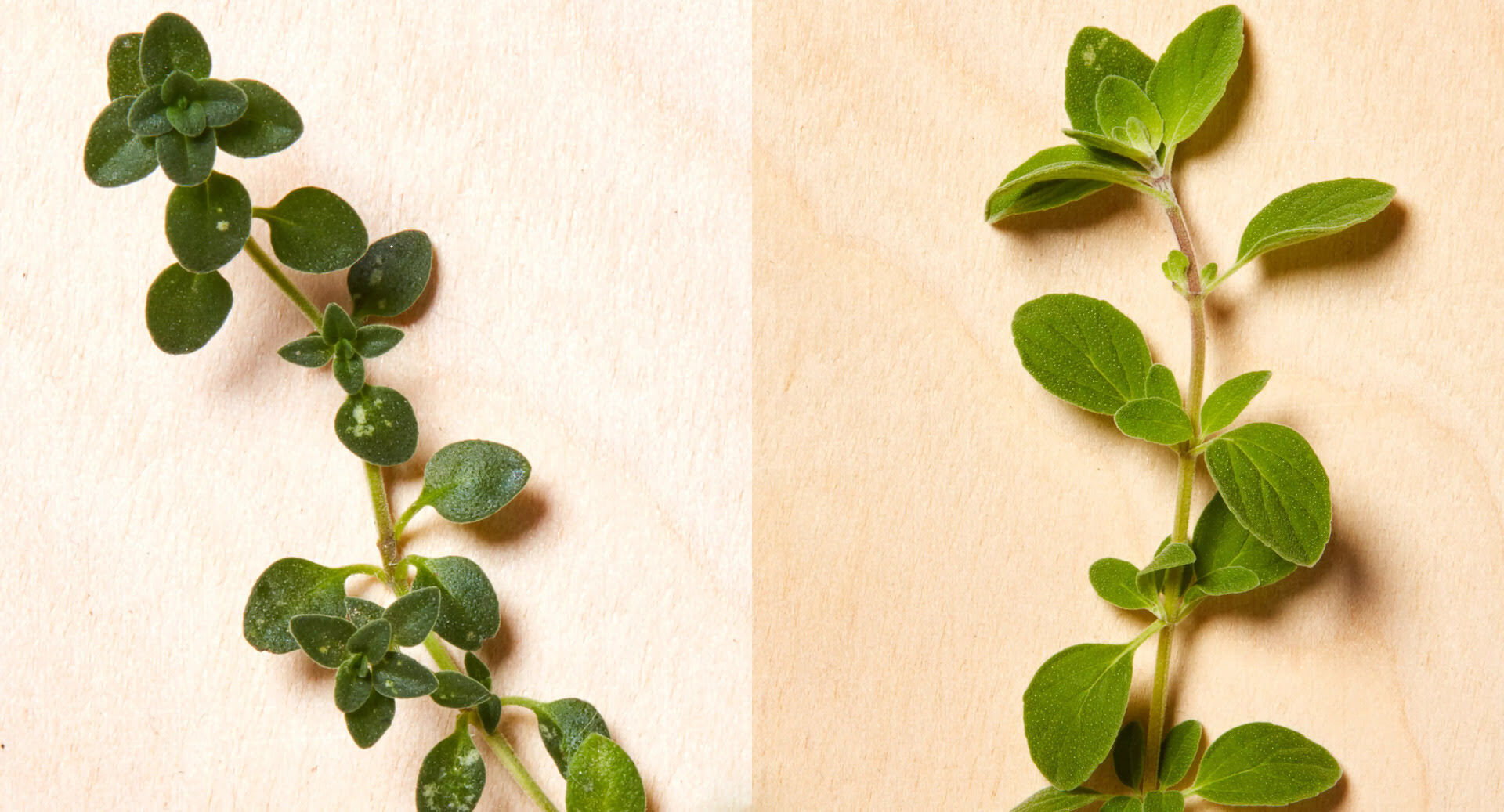Home>Garden Essentials>Garden Plants>What Is The Difference Between Oregano And Thyme


Garden Plants
What Is The Difference Between Oregano And Thyme
Modified: January 5, 2024
Discover the key differences between oregano and thyme, two popular plants commonly used in cooking. Explore their unique flavors and culinary applications.
(Many of the links in this article redirect to a specific reviewed product. Your purchase of these products through affiliate links helps to generate commission for Storables.com, at no extra cost. Learn more)
Introduction:
Welcome to our guide on the fascinating world of herbs! In this article, we will explore the distinctive characteristics, flavor profiles, culinary uses, medicinal properties, and cultivation methods of two popular herbs: oregano and thyme. These versatile and aromatic herbs have been used in culinary traditions around the world for centuries, adding depth and flavor to a wide range of dishes.
Oregano and thyme may seem similar at first glance, but they have distinct features that set them apart from each other. Understanding these differences is crucial for both amateur and professional chefs, as it allows them to make informed decisions when selecting the appropriate herb for their culinary creations.
So, if you’ve ever wondered about the difference between oregano and thyme, their unique flavor profiles, or how to grow and use them, you’ve come to the right place. Let’s dive in and discover the fascinating world of these two aromatic herbs, exploring their individual characteristics and the many ways they can enhance your cooking and overall well-being.
Key Takeaways:
- Oregano and thyme are distinct herbs with unique flavors, culinary uses, and potential health benefits. Understanding their differences and characteristics allows for informed and creative culinary exploration.
- Cultivating oregano and thyme is relatively straightforward, offering a convenient and fresh supply of aromatic leaves for enhancing culinary creations. Their versatility makes them indispensable in the kitchen.
Characteristics of Oregano:
Oregano, also known as Origanum vulgare, is a perennial herb from the mint family (Lamiaceae). It is native to the Mediterranean region and has been a staple in Mediterranean cuisine for centuries. Oregano is known for its small, aromatic leaves that can range in color from deep green to grayish-green. It grows in trailing or upright clusters, with a height of about 20 to 80 centimeters.
One of the key characteristics of oregano is its strong and distinct fragrance. The leaves of oregano contain essential oils, including carvacrol and thymol, which contribute to its intense and slightly peppery scent. When crushed or bruised, the leaves release their oils, intensifying the aroma.
In terms of flavor, oregano offers a delightful combination of bitterness and warmth, with subtle hints of sweetness. It is often described as pungent, with a slightly spicy and earthy taste. This robust flavor makes oregano a popular choice for adding depth to various dishes.
Another noteworthy characteristic of oregano is its versatility. It pairs well with a wide range of ingredients and can be used either fresh or dried. Oregano is a staple herb in Italian cuisine, where it is commonly used in tomato-based sauces, pizzas, and pasta dishes. It also complements grilled meats, roasted vegetables, and Mediterranean-inspired salads.
When it comes to medicinal properties, oregano has been valued for its antibacterial, antifungal, and antioxidant properties. It has been used in traditional herbal medicine to treat respiratory issues, digestive problems, and even skin conditions. Oregano is also rich in vitamins and minerals, including vitamin K, iron, and calcium, making it a nutritious addition to your diet.
In terms of cultivation, oregano is relatively easy to grow and can be cultivated both indoors and outdoors. It thrives in well-drained soil, with full sun exposure. Oregano plants are resilient and can withstand drought conditions, making them suitable for various climates and growing conditions.
Whether you’re cooking up a classic Italian dish or exploring new culinary creations, the characteristics of oregano make it a valuable herb to have in your kitchen. Its distinct aroma, robust flavor, and health benefits make it a versatile and essential ingredient in many cuisines around the world.
Characteristics of Thyme:
Thyme, scientifically known as Thymus vulgaris, is a perennial herb native to the Mediterranean region. It is a member of the mint family (Lamiaceae) and is renowned for its aromatic and flavorful leaves. Thyme plants grow in small shrubs, reaching a height of about 15 to 30 centimeters, with woody stems and tiny elliptical leaves.
One of the distinctive characteristics of thyme is its fragrant nature. When the leaves are gently rubbed or crushed, they release a delightful aroma that is often described as earthy, herby, and slightly floral. This fragrant quality is due to the essential oils contained within the leaves, including thymol, carvacrol, and linalool.
Thyme offers a unique flavor profile that is slightly minty, mildly pungent, and somewhat reminiscent of cloves. It has a subtle sweetness and a hint of bitterness, which adds complexity to a variety of dishes. Thyme is known for its ability to enhance the flavors of meat, poultry, fish, soups, stews, and roasted vegetables.
In addition to its culinary uses, thyme has long been recognized for its medicinal properties. It contains compounds with antimicrobial, antifungal, and antioxidant properties, making it an excellent herb for supporting the immune system and promoting overall well-being. Thyme has also been used traditionally to aid digestion, soothe coughs and sore throats, and alleviate respiratory issues.
Cultivating thyme is relatively straightforward, as it is a resilient and low-maintenance herb. It prefers well-drained soil and thrives in full sun exposure. Thyme plants can be grown both in containers and in the ground, making them a versatile option for gardens of all sizes. With proper care, thyme can provide a steady supply of aromatic leaves for your culinary endeavors.
Thyme is a staple herb in Mediterranean, Middle Eastern, and European cuisines, where it is used in a wide range of dishes. Its versatility and distinct flavor make it a prized ingredient in savory recipes, such as marinades, dressings, roasted meats, grilled vegetables, and herbal teas. Thyme’s flavor profile is well-suited to complement both simple and complex flavor combinations, adding depth and sophistication to any dish.
With its aromatic charm, culinary versatility, and potential health benefits, thyme is a herb that deserves a place in every kitchen. Its unique characteristics make it a valuable ingredient that can elevate your cooking to new heights, whether you’re a seasoned chef or an enthusiastic home cook.
Flavor Profile of Oregano:
Oregano is renowned for its robust and distinctive flavor profile, which adds depth and complexity to a wide range of dishes. The flavor of oregano is often described as pungent, earthy, and slightly bitter, with hints of warmth and a subtle sweetness.
The key components of oregano’s flavor come from the essential oils present in its leaves, particularly carvacrol and thymol. These oils contribute to the herb’s intense aroma and distinct taste. When used in moderation, oregano can enhance the overall flavor profile of a dish, giving it a savory and aromatic quality.
Oregano pairs exceptionally well with tomatoes, making it a staple herb in many Italian dishes. It adds a zesty and herbaceous note to tomato-based sauces, pizzas, and pasta dishes. Oregano also complements other herbs like basil, thyme, and rosemary, creating a harmonious blend of flavors.
When used in dried form, oregano develops a more concentrated flavor. Its potency becomes more pronounced, so it is important to use it in moderation to avoid overpowering the dish. Dried oregano is commonly used in spice blends, marinades, and rubs for meats and vegetables.
As with many herbs, the flavor of oregano can vary depending on its growing conditions, the time of harvest, and the specific variety. Greek oregano, for example, is known for its strong and slightly bitter taste, while Italian oregano has a milder and sweeter flavor.
Overall, the flavor profile of oregano adds depth, warmth, and aromatic notes to dishes. Whether used fresh or dried, in Mediterranean, Mexican, or even Middle Eastern cuisines, oregano has the ability to elevate the flavors and create a satisfying and memorable culinary experience.
Flavor Profile of Thyme:
Thyme is renowned for its unique and delightful flavor profile, adding a distinct taste to various dishes. The flavor of thyme is characterized as minty, slightly pungent, and subtly floral, with notes of clove. It offers a wonderful balance of sweetness and bitterness, making it a versatile herb in the culinary world.
The essential oils present in thyme, such as thymol and carvacrol, contribute to its aromatic and flavorful profile. When the leaves are crushed or heated, these oils are released, intensifying the herb’s taste and aroma.
Thyme is often described as having a warm and earthy flavor that complements a wide range of savory dishes. It pairs exceptionally well with meats, poultry, fish, and vegetables, adding depth and complexity to their flavors. The herb’s minty undertones can provide a refreshing and cooling effect on the palate.
When added to dishes, thyme imparts a subtle sweetness that can enhance the overall flavor profile. It can be used in various forms, such as fresh leaves, dried leaves, or even as part of herb blends. The dried version of thyme has a more concentrated flavor compared to fresh thyme, so it should be used sparingly to avoid overpowering the dish.
Thyme is a staple herb in many cuisines around the world, including Mediterranean, Middle Eastern, and French. It is commonly used in roasted meats, soups, stews, sauces, marinades, and dressings. Thyme also pairs well with other herbs like rosemary, sage, and oregano, creating a harmonious blend of flavors.
In addition to its culinary uses, thyme has been recognized for its potential health benefits. It contains antioxidants and antimicrobial compounds that may support the immune system and contribute to overall well-being. Thyme is also used in traditional herbal medicine to alleviate respiratory issues, aid digestion, and soothe coughs and sore throats.
Overall, the flavor profile of thyme adds depth, warmth, and a hint of mintiness to dishes. Its versatility and aromatic qualities make it a prized herb in the culinary world, allowing chefs and home cooks to create flavorful and memorable meals.
Culinary Uses of Oregano:
Oregano is a versatile herb that is widely used in various culinary traditions, particularly in Mediterranean and Italian cuisines. Its robust flavor and aroma make it a popular choice for enhancing the taste of countless dishes. Here are some common culinary uses of oregano:
- Pizza and Pasta: Oregano is an essential ingredient in pizza and pasta dishes, particularly those with tomato-based sauces. Sprinkling dried or fresh oregano over the pizza or pasta adds a zesty and herbaceous flavor, complementing the richness of the sauce and cheese.
- Soups and Stews: Oregano brings depth and warmth to soups and stews. Whether it’s a classic minestrone soup or a hearty beef stew, adding oregano provides a savory and aromatic note that enhances the overall flavor profile.
- Grilled Meats and Vegetables: Oregano pairs well with grilled meats and vegetables, adding a delicious herbaceous flavor to the charred and smoky notes. It works particularly well with lamb, chicken, and pork, as well as vegetables like eggplant, zucchini, and bell peppers.
- Tomato-Based Sauces: Oregano is a staple herb in tomato-based sauces, such as marinara sauce and bolognese sauce. It adds depth and complexity to the flavors, balancing the sweetness of the tomatoes and bringing a vibrant and aromatic quality to the sauce.
- Salads and Dressings: Fresh oregano leaves can be used to liven up salads and dressings. The leaves can be chopped and added to green salads, pasta salads, or grain bowls for a burst of flavor. Oregano-infused dressings provide a unique and vibrant taste to your favorite salads.
- Herb Butter and Marinades: Oregano is often incorporated into herb butter and marinades to enhance the flavors of grilled or roasted meats. The combination of oregano with other herbs, such as rosemary, thyme, and garlic, creates a savory and aromatic blend that infuses the meat with deliciousness.
Whether used fresh or dried, oregano is a fantastic herb that can elevate the taste of numerous dishes. It adds a distinctive and robust flavor that works well in both simple and complex recipes. The versatility of oregano makes it a must-have herb in any well-stocked kitchen, allowing you to create flavorful and memorable meals.
Oregano has a strong, pungent flavor with hints of citrus and pepper, while thyme has a more subtle, earthy flavor with a hint of mint. Use oregano in Mediterranean dishes and thyme in French cuisine.
Culinary Uses of Thyme:
Thyme is a versatile herb with a unique flavor profile that adds depth and complexity to a wide range of culinary creations. Its aromatic and savory taste makes it a popular choice in many cuisines. Here are some common culinary uses of thyme:
- Roasted Meats and Poultry: Thyme pairs exceptionally well with roasted meats, particularly beef, lamb, and poultry. Sprinkling fresh or dried thyme leaves over the meat before cooking infuses it with a savory and herbaceous flavor that complements the richness of the meat.
- Soups, Stews, and Stocks: Thyme is a key ingredient in soups, stews, and stocks, adding depth and aroma to the base. It works well with both vegetable and meat-based recipes, enhancing the overall flavor profile with its minty and slightly earthy notes.
- Sauces and Marinades: Thyme can be used in sauces and marinades to impart a delicious herbal taste. Whether it’s a classic tomato sauce, a tangy barbecue marinade, or a buttery cream sauce, the addition of thyme adds complexity and a unique herbal note.
- Herb-Roasted Vegetables: Thyme enhances the flavors of roasted vegetables, particularly root vegetables like potatoes, carrots, and parsnips. Tossing the vegetables with olive oil, salt, pepper, and fresh thyme leaves before roasting brings out their natural sweetness and adds a delightful herbaceous touch.
- Breads and Baked Goods: Thyme can be incorporated into bread dough and baked goods, such as focaccia or herbed biscuits, to impart a wonderful aroma and flavor. It adds a hint of mintiness and herbaceousness that complements the dough and elevates the overall taste.
- Cheese and Charcuterie Boards: Fresh sprigs of thyme can be used as a garnish on cheese and charcuterie boards. It not only adds visual appeal but also provides a refreshing and aromatic element that enhances the taste of the cheeses and cured meats.
- Herbal Teas and Infusions: Thyme leaves can be used to make herbal teas and infusions. The leaves release their aromatic oils when steeped in hot water, creating a soothing and flavorful beverage that is believed to have calming and digestive properties.
Thyme’s versatile flavor and versatility make it a valuable herb in the kitchen, offering a multitude of delicious possibilities. Whether used in savory dishes, breads, or beverages, thyme brings a unique herbal character that enhances the overall culinary experience.
Medicinal Properties of Oregano:
Oregano not only adds flavor to culinary creations but also possesses several medicinal properties, making it a valuable herb with potential health benefits. Here are some of the medicinal properties associated with oregano:
- Antibacterial and Antifungal: Oregano contains compounds, such as carvacrol and thymol, which have antimicrobial properties. These properties make oregano effective against various bacterial and fungal strains. It may help in fighting infections and promoting overall health.
- Antioxidant: Oregano is rich in antioxidants, including rosmarinic acid and polyphenols. These antioxidants help protect the body from damage caused by free radicals, which can contribute to aging and chronic illnesses.
- Anti-inflammatory: Oregano possesses anti-inflammatory properties that may help reduce inflammation in the body. Chronic inflammation has been linked to various health conditions, and consuming oregano may contribute to managing inflammation levels.
- Digestive Aid: Oregano has traditionally been used to support digestion and alleviate digestive issues. It may help reduce bloating, stimulate the production of digestive enzymes, and promote healthy digestion.
- Respiratory Support: Oregano has been used to support respiratory health for centuries. It contains compounds that may help soothe coughs, relieve congestion, and support the immune system in fighting respiratory infections.
- Antimicrobial for Oral Health: Oregano’s antimicrobial properties may also be beneficial for oral health. It may help combat bacteria that cause bad breath, plaque buildup, and gum disease. Some oral care products contain oregano oil for its potential antimicrobial effects.
- Skin Health: Oregano oil has been used topically to address various skin issues, including acne and fungal infections. Its antimicrobial properties may help combat the underlying causes of these conditions.
While oregano has been used for centuries in traditional medicine, it is important to note that more scientific research is needed to fully understand and validate its medicinal benefits. As with any natural remedies, it’s recommended to exercise caution and consult with a healthcare professional.
When using oregano for its potential medicinal properties, the dried or fresh herb can be incorporated into cooking, herbal teas, or infusions. Oregano essential oil is also available and should be used sparingly and with caution, as it is highly concentrated.
Overall, oregano offers a range of potential health benefits due to its antibacterial, antifungal, antioxidant, anti-inflammatory, and digestive properties. Incorporating this aromatic herb into your diet may be a flavorful way to support your overall well-being.
Medicinal Properties of Thyme:
Thyme is not only a flavorful herb but also boasts several medicinal properties that have been recognized for centuries. Its unique combination of compounds provides potential health benefits. Here are some of the medicinal properties associated with thyme:
- Antimicrobial and Antiseptic: Thyme contains compounds, such as thymol and carvacrol, which possess antimicrobial and antiseptic properties. These properties may help combat bacteria, viruses, and fungi, making thyme a potential natural remedy for certain infections.
- Antioxidant: Thyme is rich in antioxidants, including flavonoids and phenolic compounds, which help protect the body against oxidative stress caused by free radicals. Antioxidants play a crucial role in supporting overall health and reducing the risk of chronic diseases.
- Anti-inflammatory: Thyme exhibits anti-inflammatory properties that may help reduce inflammation in the body. Chronic inflammation is associated with various health conditions, and incorporating thyme into your diet may contribute to managing inflammation levels.
- Respiratory Health: Thyme has long been used to support respiratory health. It contains compounds that may help alleviate coughs, congestion, and bronchial issues. Thyme-infused herbal teas and steam inhalation with thyme oil are popular natural remedies for respiratory relief.
- Digestive Aid: Thyme may help support digestion by stimulating the secretion of digestive enzymes, aiding in the breakdown of food. It may also help alleviate indigestion, bloating, and gastrointestinal discomfort.
- Relaxation and Calming: Thyme has been traditionally used for its soothing properties. It may help promote relaxation and reduce stress levels. Thyme-infused herbal teas or aromatherapy using thyme essential oil can contribute to a sense of calm and tranquility.
- Oral Health: Thyme’s antimicrobial properties make it beneficial for oral health. It may help combat oral bacteria, reduce bad breath, and support gum health. Some natural oral care products contain thyme extract or oil for its potential antimicrobial effects.
- Skin Health: Thyme has been used for topical applications to address certain skin conditions. Its antimicrobial properties may help with acne-prone skin, fungal infections, and skin irritations.
Though thyme has a long history of medicinal use, further research is needed to fully understand and validate its potential health benefits. As with any natural remedies, it is advised to consult with a healthcare professional before using thyme for medicinal purposes.
To harness the potential health benefits of thyme, it can be used in various forms, including fresh leaves, dried leaves, or thyme essential oil. Incorporating thyme into cooking, herbal teas, or topical applications may provide a natural way to support your well-being.
Remember, while thyme offers potential benefits, it is not meant to replace medical advice or treatment. It should be used as a complementary approach to a healthy lifestyle and in consultation with a qualified healthcare professional.
Growing and Cultivating Oregano:
Oregano is a relatively easy herb to grow and cultivate, making it a fantastic addition to any herb garden or container. Whether you have a spacious backyard or limited space on a balcony, here are some tips for successfully growing and cultivating oregano:
- Choose the Right Location: Oregano thrives in full sun, so select a location that receives at least 6 to 8 hours of direct sunlight each day. Ensure the soil is well-draining to prevent waterlogged roots, as excessive moisture can lead to root rot.
- Prepare the Soil: Before planting oregano, prepare the soil by loosening it with a garden fork or tiller. Mix in some organic compost to improve drainage and provide nutrients for healthy growth.
- Sow the Seeds: If starting from seeds, plant them shallowly, about 1/4 inch deep, in the prepared soil. Space the seeds approximately 8 to 10 inches apart to allow for proper growth. Lightly cover them with soil and gently water the area.
- Transplanting Seedlings: If you prefer to start with seedlings, plant them in the prepared soil at the same spacing as the seeds. Dig a hole slightly larger than the root ball, place the seedling in the hole, and backfill with soil. Water thoroughly after planting.
- Watering: Oregano is a drought-tolerant herb that prefers slightly dry conditions. Water the plants deeply but infrequently, allowing the soil to dry out between watering sessions. Overwatering can lead to root rot, so it’s crucial to strike a balance.
- Pruning and Harvesting: Regular pruning helps to promote bushier growth and prevent the plant from becoming overgrown. Once the oregano reaches a height of about 4 to 6 inches, begin harvesting by snipping off the topmost leaves. Avoid removing more than one-third of the plant at a time.
- Overwintering: Oregano is a perennial herb that can withstand colder temperatures. In regions with harsh winters, provide a layer of mulch around the base of the plant to protect the roots from freezing. This will help the plant survive and regrow in the following season.
- Propagation: Oregano can be propagated through stem cuttings or by dividing an established plant. Take stem cuttings from healthy plants, remove the lower leaves, and place them in a container with moist soil. Keep them in a warm and bright location until they develop roots.
By following these guidelines, you can enjoy a bountiful supply of fresh oregano leaves throughout the growing season. Whether used immediately in your culinary creations or dried for future use, homegrown oregano will add a delightful and aromatic touch to your cooking.
Remember to monitor the plants for any signs of pests or diseases, and take appropriate measures, such as using organic insecticides or natural remedies, to protect the plants if needed.
With proper care and attention, you can cultivate a thriving oregano plant that will reward you with its flavorful leaves for years to come.
Growing and Cultivating Thyme:
Thyme is a versatile herb that is relatively easy to grow and cultivate. Whether you have a garden bed or limited space, here are some tips for successfully growing and cultivating thyme:
- Choose the Right Location: Thyme thrives in full sun, so select a location that receives at least 6 to 8 hours of direct sunlight per day. It also prefers well-draining soil with a pH level between 6.0 and 8.0.
- Prepare the Soil: Before planting thyme, prepare the soil by removing any weeds or grass. Loosen the soil with a garden fork or tiller and incorporate some organic compost to provide nutrients and improve drainage.
- Sow the Seeds or Transplant Seedlings: Thyme can be started from seeds or seedlings. If using seeds, sprinkle them lightly on the prepared soil and cover them with a thin layer of soil. If using seedlings, dig holes slightly larger than the root balls and space them 8 to 12 inches apart.
- Watering: Thyme is a drought-tolerant herb that prefers slightly dry conditions. Water the plants deeply but infrequently, allowing the soil to dry out between watering sessions. Avoid overwatering, as thyme is susceptible to root rot in waterlogged soil.
- Pruning: Prune thyme regularly to promote bushier growth and prevent it from becoming leggy. After the plant has established, trim the stems back by one-third to encourage new growth. Avoid cutting back more than one-third of the plant at a time.
- Harvesting: Thyme can be harvested once the plant is established and has a good amount of foliage. Clip sprigs of thyme as needed, cutting just above a pair of leaves. Regular harvesting encourages new growth and keeps the plant productive.
- Overwintering: Thyme is a perennial herb that can withstand colder temperatures. In regions with harsh winters, apply a layer of mulch around the base of the plant to protect the roots from freezing. This will help the plant survive and regrow in the following season.
- Propagation: Thyme can be propagated through stem cuttings. Take 3 to 4-inch cuttings from healthy plants, remove the lower leaves, and place them in a container with moist potting soil. Keep the cuttings in a warm and bright location until they develop roots.
Thyme is a low-maintenance herb that is resistant to many pests and diseases, making it an excellent choice for beginner gardeners. However, keep an eye out for common pests like aphids and spider mites, and take appropriate measures, such as using natural insecticides or companion planting, if necessary.
With proper care and attention, you can cultivate a thriving thyme plant that will provide you with its aromatic leaves for culinary use and potential medicinal benefits. Whether used fresh or dried, thyme will add a wonderful flavor and fragrance to your favorite dishes.
Remember to experiment with different thyme varieties, such as common thyme (Thymus vulgaris), lemon thyme (Thymus citriodorus), or creeping thyme (Thymus serpyllum), to explore various flavors and appearances. Enjoy the process of growing and using this versatile herb in your culinary adventures.
Conclusion:
Oregano and thyme are two remarkable herbs that offer unique characteristics, captivating flavor profiles, diverse culinary uses, and potential health benefits. Understanding the differences between these herbs allows us to appreciate their individual qualities and make informed choices when incorporating them into our cooking and overall well-being.
Oregano, with its robust flavor and distinct aroma, is a staple in Mediterranean and Italian cuisines. It pairs well with tomatoes, making it a key ingredient in sauces, pizzas, and pasta dishes. Oregano’s medicinal properties, including its antibacterial and antioxidant qualities, add to its appeal in both culinary and traditional herbal medicine practices.
Thyme, known for its minty and slightly floral flavor, enhances the taste of various dishes in Mediterranean, Middle Eastern, and European cuisines. It complements roasted meats, soups, stews, and grilled vegetables. Thyme’s potential health benefits, such as its antimicrobial, anti-inflammatory, and respiratory support properties, add to its reputation as a versatile herb.
When it comes to growing and cultivating oregano and thyme, both herbs are relatively easy to maintain. They thrive in sunny locations with well-draining soil and require minimal watering. Regular pruning and harvesting promote healthy growth and ensure a continuous supply of fresh leaves.
As we explore the culinary and medicinal uses of oregano and thyme, it’s important to remember that these herbs are not meant to replace professional medical advice, but rather to complement a healthy lifestyle. If you have specific health concerns or questions, it’s always best to consult a healthcare professional.
Whether used in savory dishes, soups, salads, dressings, or herbal teas, oregano and thyme add depth, complexity, and delightful aromas to our culinary creations. Their versatility allows for endless possibilities in the kitchen, making them indispensable for both professional chefs and home cooks alike.
By cultivating these herbs in our gardens or pots, we can have a fresh and convenient supply of oregano and thyme, enhancing the taste and nutritional value of our meals.
So, whether you’re sprinkling oregano over your homemade pizza or infusing thyme in your roasted vegetables, embrace the wonderful world of these herbs and savor the flavors they bring to your table.
Frequently Asked Questions about What Is The Difference Between Oregano And Thyme
Was this page helpful?
At Storables.com, we guarantee accurate and reliable information. Our content, validated by Expert Board Contributors, is crafted following stringent Editorial Policies. We're committed to providing you with well-researched, expert-backed insights for all your informational needs.














0 thoughts on “What Is The Difference Between Oregano And Thyme”